Project Proposal: Optimizing IKEA's Product Delivery Process
VerifiedAdded on 2023/03/20
|30
|9113
|94
Project
AI Summary
This project proposal addresses the optimization of IKEA's product delivery process, aiming to reduce waste and enhance customer satisfaction. The project analyzes the current product delivery process, identifying key issues such as late deliveries, damaged products, inefficient route planning, and poor communication between departments. The study employs techniques like SIPOC and Pareto charts to analyze root causes and proposes solutions including the implementation of a Distribution Scheduling software (DISC) system, employee training, and route optimization. The project anticipates completion within 150 days with a budget of $59,380.00. The report details internal, technological, and external risks, along with a communication plan and resource allocation, ultimately seeking to improve IKEA's sustainability and business efficiency by streamlining its product delivery operations. The project also addresses the optimization of Villa Cantu catering services.
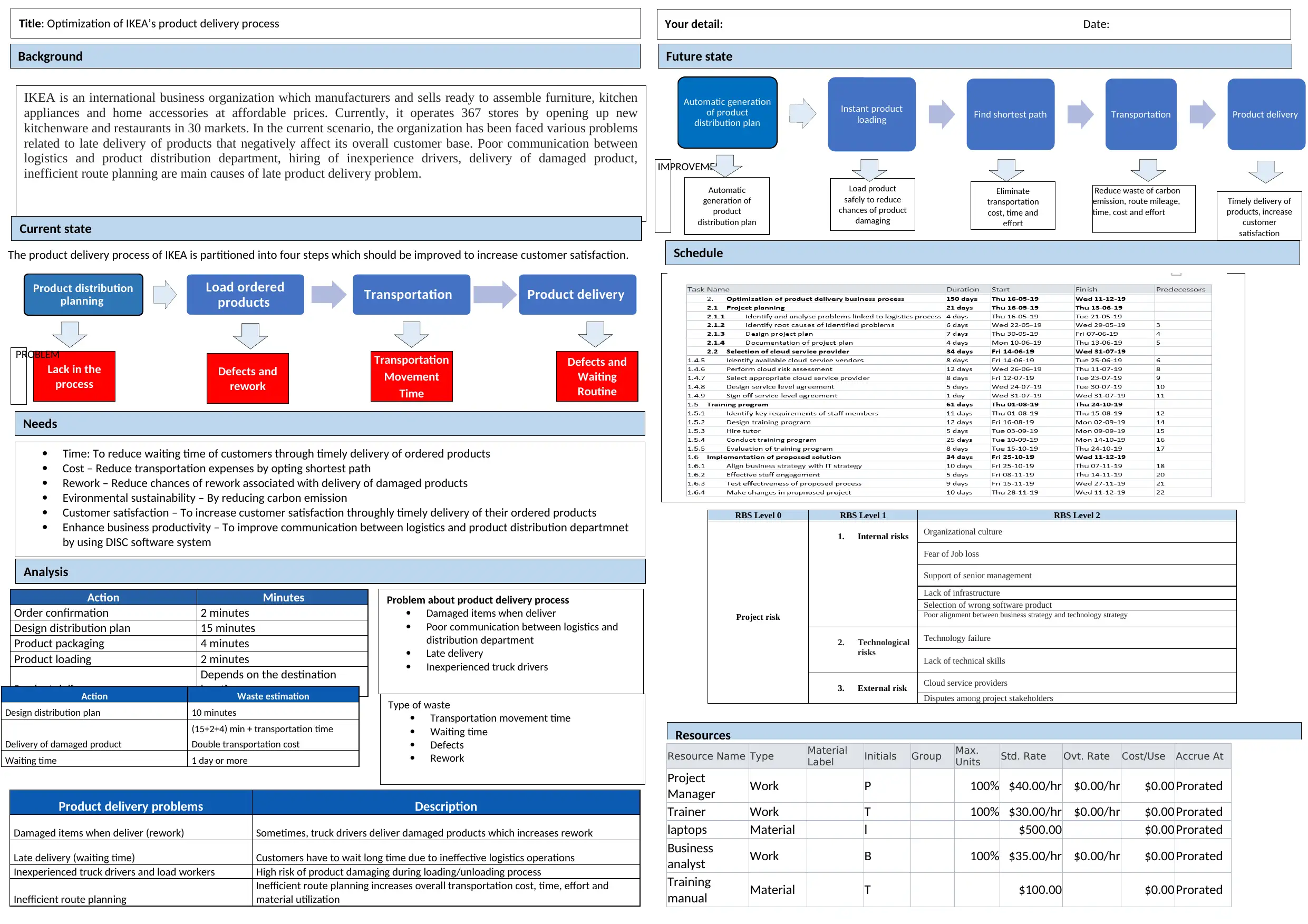
Time: To reduce waiting time of customers through timely delivery of ordered products
Cost – Reduce transportation expenses by opting shortest path
Rework – Reduce chances of rework associated with delivery of damaged products
Evironmental sustainability – By reducing carbon emission
Customer satisfaction – To increase customer satisfaction throughly timely delivery of their ordered products
Enhance business productivity – To improve communication between logistics and product distribution departmnet
by using DISC software system
Background
IKEA is an international business organization which manufacturers and sells ready to assemble furniture, kitchen
appliances and home accessories at affordable prices. Currently, it operates 367 stores by opening up new
kitchenware and restaurants in 30 markets. In the current scenario, the organization has been faced various problems
related to late delivery of products that negatively affect its overall customer base. Poor communication between
logistics and product distribution department, hiring of inexperience drivers, delivery of damaged product,
inefficient route planning are main causes of late product delivery problem.
Your detail: Date:Title: Optimization of IKEA’s product delivery process
Current state
Needs
Analysis
Future state
Schedule
Resources
Resource Name Type Material
Label Initials Group Max.
Units Std. Rate Ovt. Rate Cost/Use Accrue At
Project
Manager Work P 100% $40.00/hr $0.00/hr $0.00 Prorated
Trainer Work T 100% $30.00/hr $0.00/hr $0.00 Prorated
laptops Material l $500.00 $0.00 Prorated
Business
analyst Work B 100% $35.00/hr $0.00/hr $0.00 Prorated
Training
manual Material T $100.00 $0.00 Prorated
Defects and
rework
Transportation
Movement
Time
Defects and
Waiting
Routine
Lack in the
process
Product distribution
planning
Load ordered
products Transportation Product delivery
PROBLEM
The product delivery process of IKEA is partitioned into four steps which should be improved to increase customer satisfaction.
Automatic generation
of product
distribution plan
Instant product
loading Find shortest path Transportation Product delivery
Automatic
generation of
product
distribution plan
Load product
safely to reduce
chances of product
damaging
Eliminate
transportation
cost, time and
effort
Reduce waste of carbon
emission, route mileage,
time, cost and effort
Timely delivery of
products, increase
customer
satisfaction
IMPROVEMENT
Problem about product delivery process
Damaged items when deliver
Poor communication between logistics and
distribution department
Late delivery
Inexperienced truck drivers
Type of waste
Transportation movement time
Waiting time
Defects
Rework
Product delivery problems Description
Damaged items when deliver (rework) Sometimes, truck drivers deliver damaged products which increases rework
Late delivery (waiting time) Customers have to wait long time due to ineffective logistics operations
Inexperienced truck drivers and load workers High risk of product damaging during loading/unloading process
Inefficient route planning
Inefficient route planning increases overall transportation cost, time, effort and
material utilization
RBS Level 0 RBS Level 1 RBS Level 2
Project risk
1. Internal risks Organizational culture
Fear of Job loss
Support of senior management
Lack of infrastructure
Selection of wrong software product
Poor alignment between business strategy and technology strategy
2. Technological
risks
Technology failure
Lack of technical skills
3. External risk Cloud service providers
Disputes among project stakeholders
Action Minutes
Order confirmation 2 minutes
Design distribution plan 15 minutes
Product packaging 4 minutes
Product loading 2 minutes
Product delivery
Depends on the destination
location
Action Waste estimation
Design distribution plan 10 minutes
Delivery of damaged product
(15+2+4) min + transportation time
Double transportation cost
Waiting time 1 day or more
Cost – Reduce transportation expenses by opting shortest path
Rework – Reduce chances of rework associated with delivery of damaged products
Evironmental sustainability – By reducing carbon emission
Customer satisfaction – To increase customer satisfaction throughly timely delivery of their ordered products
Enhance business productivity – To improve communication between logistics and product distribution departmnet
by using DISC software system
Background
IKEA is an international business organization which manufacturers and sells ready to assemble furniture, kitchen
appliances and home accessories at affordable prices. Currently, it operates 367 stores by opening up new
kitchenware and restaurants in 30 markets. In the current scenario, the organization has been faced various problems
related to late delivery of products that negatively affect its overall customer base. Poor communication between
logistics and product distribution department, hiring of inexperience drivers, delivery of damaged product,
inefficient route planning are main causes of late product delivery problem.
Your detail: Date:Title: Optimization of IKEA’s product delivery process
Current state
Needs
Analysis
Future state
Schedule
Resources
Resource Name Type Material
Label Initials Group Max.
Units Std. Rate Ovt. Rate Cost/Use Accrue At
Project
Manager Work P 100% $40.00/hr $0.00/hr $0.00 Prorated
Trainer Work T 100% $30.00/hr $0.00/hr $0.00 Prorated
laptops Material l $500.00 $0.00 Prorated
Business
analyst Work B 100% $35.00/hr $0.00/hr $0.00 Prorated
Training
manual Material T $100.00 $0.00 Prorated
Defects and
rework
Transportation
Movement
Time
Defects and
Waiting
Routine
Lack in the
process
Product distribution
planning
Load ordered
products Transportation Product delivery
PROBLEM
The product delivery process of IKEA is partitioned into four steps which should be improved to increase customer satisfaction.
Automatic generation
of product
distribution plan
Instant product
loading Find shortest path Transportation Product delivery
Automatic
generation of
product
distribution plan
Load product
safely to reduce
chances of product
damaging
Eliminate
transportation
cost, time and
effort
Reduce waste of carbon
emission, route mileage,
time, cost and effort
Timely delivery of
products, increase
customer
satisfaction
IMPROVEMENT
Problem about product delivery process
Damaged items when deliver
Poor communication between logistics and
distribution department
Late delivery
Inexperienced truck drivers
Type of waste
Transportation movement time
Waiting time
Defects
Rework
Product delivery problems Description
Damaged items when deliver (rework) Sometimes, truck drivers deliver damaged products which increases rework
Late delivery (waiting time) Customers have to wait long time due to ineffective logistics operations
Inexperienced truck drivers and load workers High risk of product damaging during loading/unloading process
Inefficient route planning
Inefficient route planning increases overall transportation cost, time, effort and
material utilization
RBS Level 0 RBS Level 1 RBS Level 2
Project risk
1. Internal risks Organizational culture
Fear of Job loss
Support of senior management
Lack of infrastructure
Selection of wrong software product
Poor alignment between business strategy and technology strategy
2. Technological
risks
Technology failure
Lack of technical skills
3. External risk Cloud service providers
Disputes among project stakeholders
Action Minutes
Order confirmation 2 minutes
Design distribution plan 15 minutes
Product packaging 4 minutes
Product loading 2 minutes
Product delivery
Depends on the destination
location
Action Waste estimation
Design distribution plan 10 minutes
Delivery of damaged product
(15+2+4) min + transportation time
Double transportation cost
Waiting time 1 day or more
Paraphrase This Document
Need a fresh take? Get an instant paraphrase of this document with our AI Paraphraser
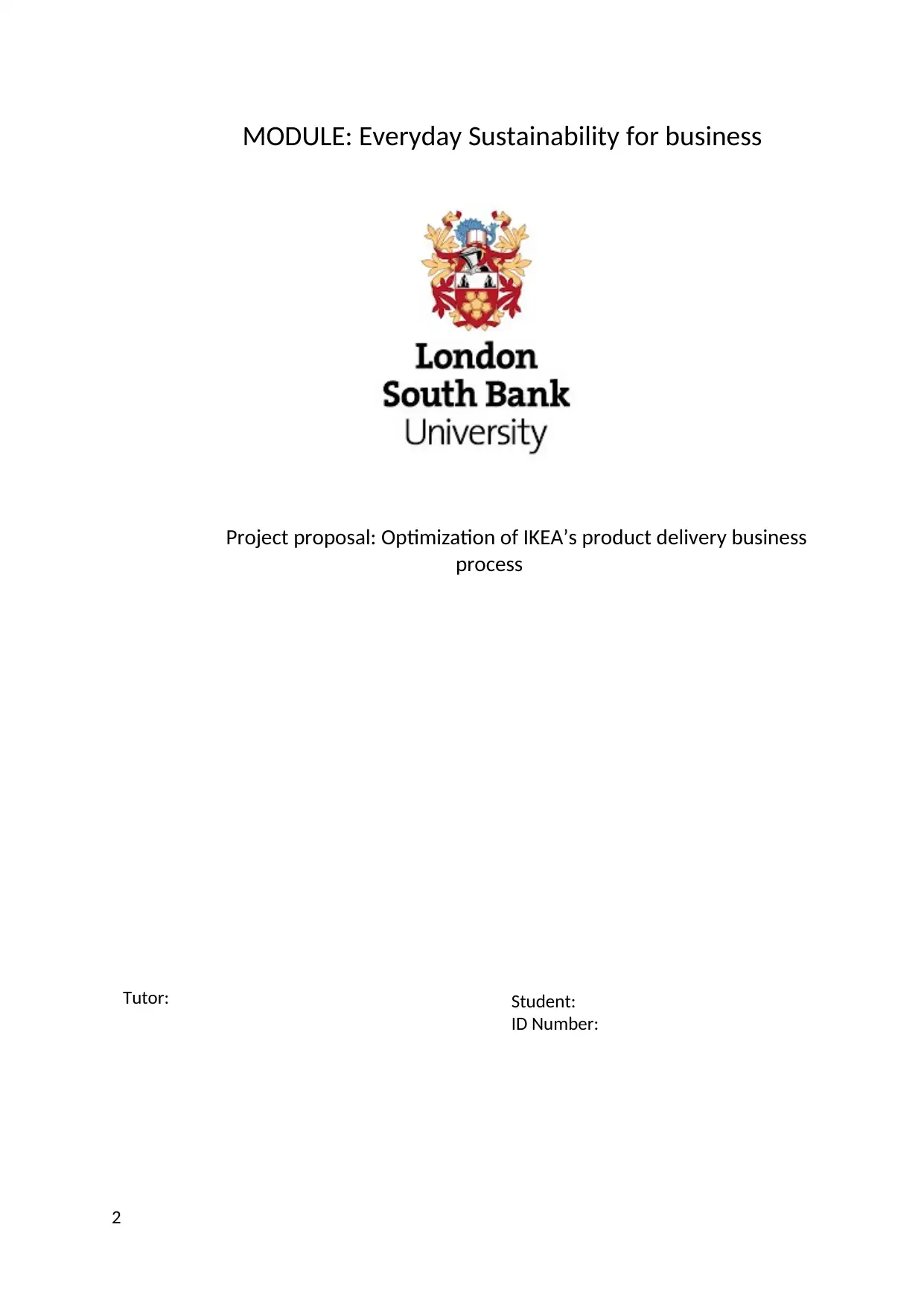
Project proposal: Optimization of IKEA’s product delivery business
process
2
Tutor:
MODULE: Everyday Sustainability for business
Student:
ID Number:
process
2
Tutor:
MODULE: Everyday Sustainability for business
Student:
ID Number:
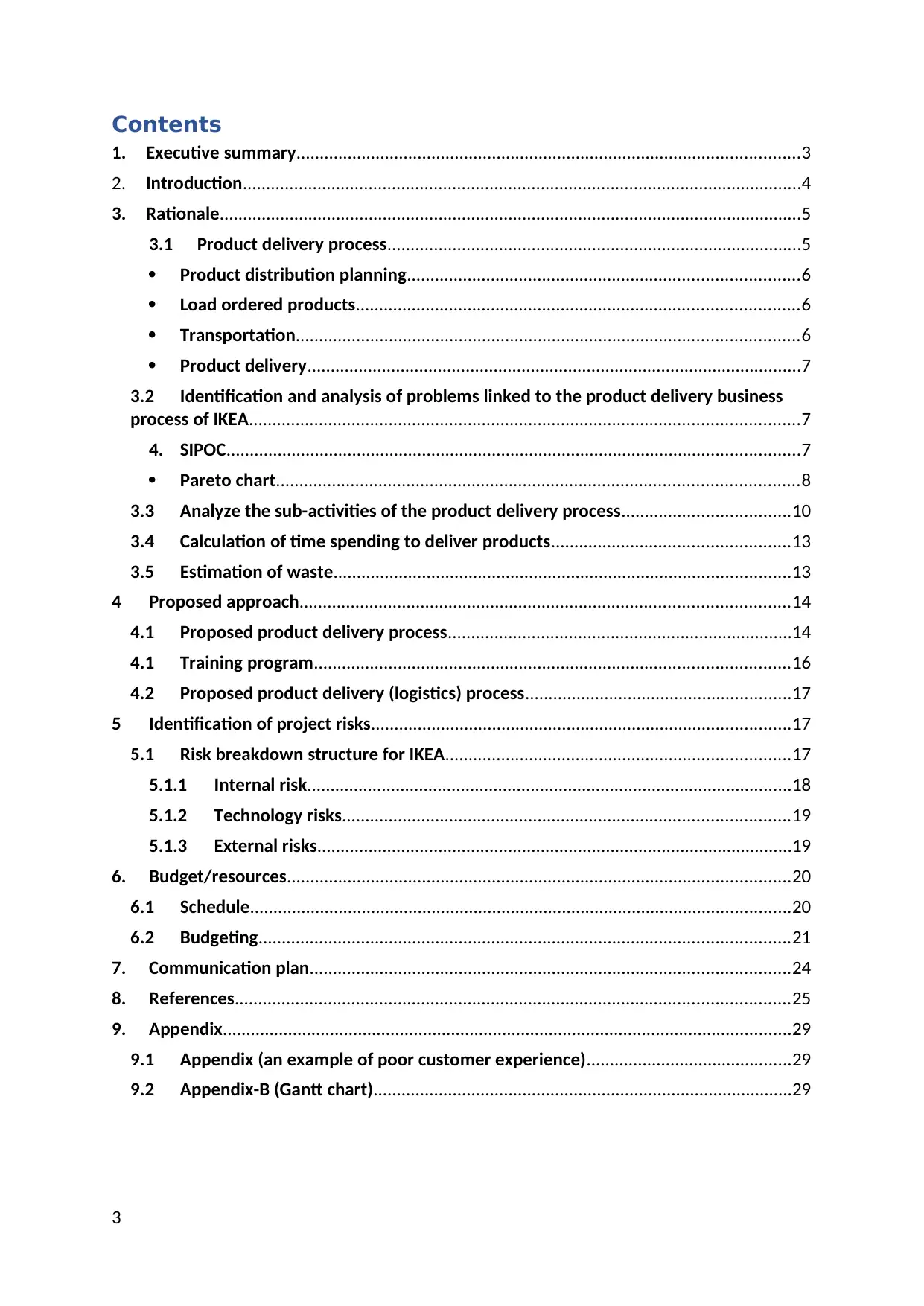
Contents
1. Executive summary............................................................................................................3
2. Introduction........................................................................................................................4
3. Rationale.............................................................................................................................5
3.1 Product delivery process.........................................................................................5
Product distribution planning....................................................................................6
Load ordered products...............................................................................................6
Transportation............................................................................................................6
Product delivery..........................................................................................................7
3.2 Identification and analysis of problems linked to the product delivery business
process of IKEA......................................................................................................................7
4. SIPOC...........................................................................................................................7
Pareto chart................................................................................................................8
3.3 Analyze the sub-activities of the product delivery process....................................10
3.4 Calculation of time spending to deliver products...................................................13
3.5 Estimation of waste..................................................................................................13
4 Proposed approach.........................................................................................................14
4.1 Proposed product delivery process..........................................................................14
4.1 Training program......................................................................................................16
4.2 Proposed product delivery (logistics) process.........................................................17
5 Identification of project risks..........................................................................................17
5.1 Risk breakdown structure for IKEA..........................................................................17
5.1.1 Internal risk........................................................................................................18
5.1.2 Technology risks................................................................................................19
5.1.3 External risks......................................................................................................19
6. Budget/resources............................................................................................................20
6.1 Schedule....................................................................................................................20
6.2 Budgeting..................................................................................................................21
7. Communication plan.......................................................................................................24
8. References.......................................................................................................................25
9. Appendix..........................................................................................................................29
9.1 Appendix (an example of poor customer experience)............................................29
9.2 Appendix-B (Gantt chart)..........................................................................................29
3
1. Executive summary............................................................................................................3
2. Introduction........................................................................................................................4
3. Rationale.............................................................................................................................5
3.1 Product delivery process.........................................................................................5
Product distribution planning....................................................................................6
Load ordered products...............................................................................................6
Transportation............................................................................................................6
Product delivery..........................................................................................................7
3.2 Identification and analysis of problems linked to the product delivery business
process of IKEA......................................................................................................................7
4. SIPOC...........................................................................................................................7
Pareto chart................................................................................................................8
3.3 Analyze the sub-activities of the product delivery process....................................10
3.4 Calculation of time spending to deliver products...................................................13
3.5 Estimation of waste..................................................................................................13
4 Proposed approach.........................................................................................................14
4.1 Proposed product delivery process..........................................................................14
4.1 Training program......................................................................................................16
4.2 Proposed product delivery (logistics) process.........................................................17
5 Identification of project risks..........................................................................................17
5.1 Risk breakdown structure for IKEA..........................................................................17
5.1.1 Internal risk........................................................................................................18
5.1.2 Technology risks................................................................................................19
5.1.3 External risks......................................................................................................19
6. Budget/resources............................................................................................................20
6.1 Schedule....................................................................................................................20
6.2 Budgeting..................................................................................................................21
7. Communication plan.......................................................................................................24
8. References.......................................................................................................................25
9. Appendix..........................................................................................................................29
9.1 Appendix (an example of poor customer experience)............................................29
9.2 Appendix-B (Gantt chart)..........................................................................................29
3
⊘ This is a preview!⊘
Do you want full access?
Subscribe today to unlock all pages.

Trusted by 1+ million students worldwide
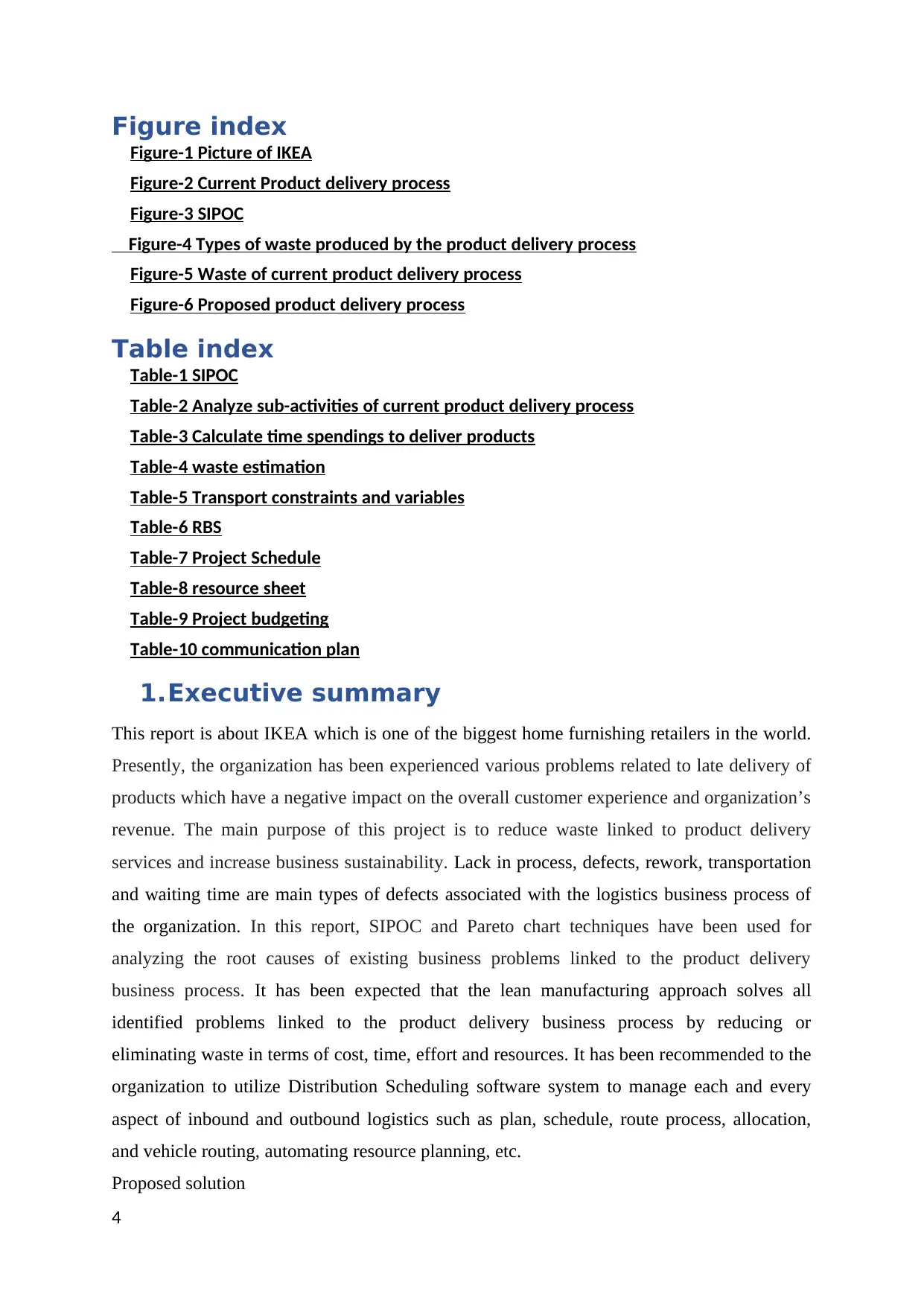
Figure index
Figure-1 Picture of IKEA
Figure-2 Current Product delivery process
Figure-3 SIPOC
Figure-4 Types of waste produced by the product delivery process
Figure-5 Waste of current product delivery process
Figure-6 Proposed product delivery process
Table index
Table-1 SIPOC
Table-2 Analyze sub-activities of current product delivery process
Table-3 Calculate time spendings to deliver products
Table-4 waste estimation
Table-5 Transport constraints and variables
Table-6 RBS
Table-7 Project Schedule
Table-8 resource sheet
Table-9 Project budgeting
Table-10 communication plan
1.Executive summary
This report is about IKEA which is one of the biggest home furnishing retailers in the world.
Presently, the organization has been experienced various problems related to late delivery of
products which have a negative impact on the overall customer experience and organization’s
revenue. The main purpose of this project is to reduce waste linked to product delivery
services and increase business sustainability. Lack in process, defects, rework, transportation
and waiting time are main types of defects associated with the logistics business process of
the organization. In this report, SIPOC and Pareto chart techniques have been used for
analyzing the root causes of existing business problems linked to the product delivery
business process. It has been expected that the lean manufacturing approach solves all
identified problems linked to the product delivery business process by reducing or
eliminating waste in terms of cost, time, effort and resources. It has been recommended to the
organization to utilize Distribution Scheduling software system to manage each and every
aspect of inbound and outbound logistics such as plan, schedule, route process, allocation,
and vehicle routing, automating resource planning, etc.
Proposed solution
4
Figure-1 Picture of IKEA
Figure-2 Current Product delivery process
Figure-3 SIPOC
Figure-4 Types of waste produced by the product delivery process
Figure-5 Waste of current product delivery process
Figure-6 Proposed product delivery process
Table index
Table-1 SIPOC
Table-2 Analyze sub-activities of current product delivery process
Table-3 Calculate time spendings to deliver products
Table-4 waste estimation
Table-5 Transport constraints and variables
Table-6 RBS
Table-7 Project Schedule
Table-8 resource sheet
Table-9 Project budgeting
Table-10 communication plan
1.Executive summary
This report is about IKEA which is one of the biggest home furnishing retailers in the world.
Presently, the organization has been experienced various problems related to late delivery of
products which have a negative impact on the overall customer experience and organization’s
revenue. The main purpose of this project is to reduce waste linked to product delivery
services and increase business sustainability. Lack in process, defects, rework, transportation
and waiting time are main types of defects associated with the logistics business process of
the organization. In this report, SIPOC and Pareto chart techniques have been used for
analyzing the root causes of existing business problems linked to the product delivery
business process. It has been expected that the lean manufacturing approach solves all
identified problems linked to the product delivery business process by reducing or
eliminating waste in terms of cost, time, effort and resources. It has been recommended to the
organization to utilize Distribution Scheduling software system to manage each and every
aspect of inbound and outbound logistics such as plan, schedule, route process, allocation,
and vehicle routing, automating resource planning, etc.
Proposed solution
4
Paraphrase This Document
Need a fresh take? Get an instant paraphrase of this document with our AI Paraphraser
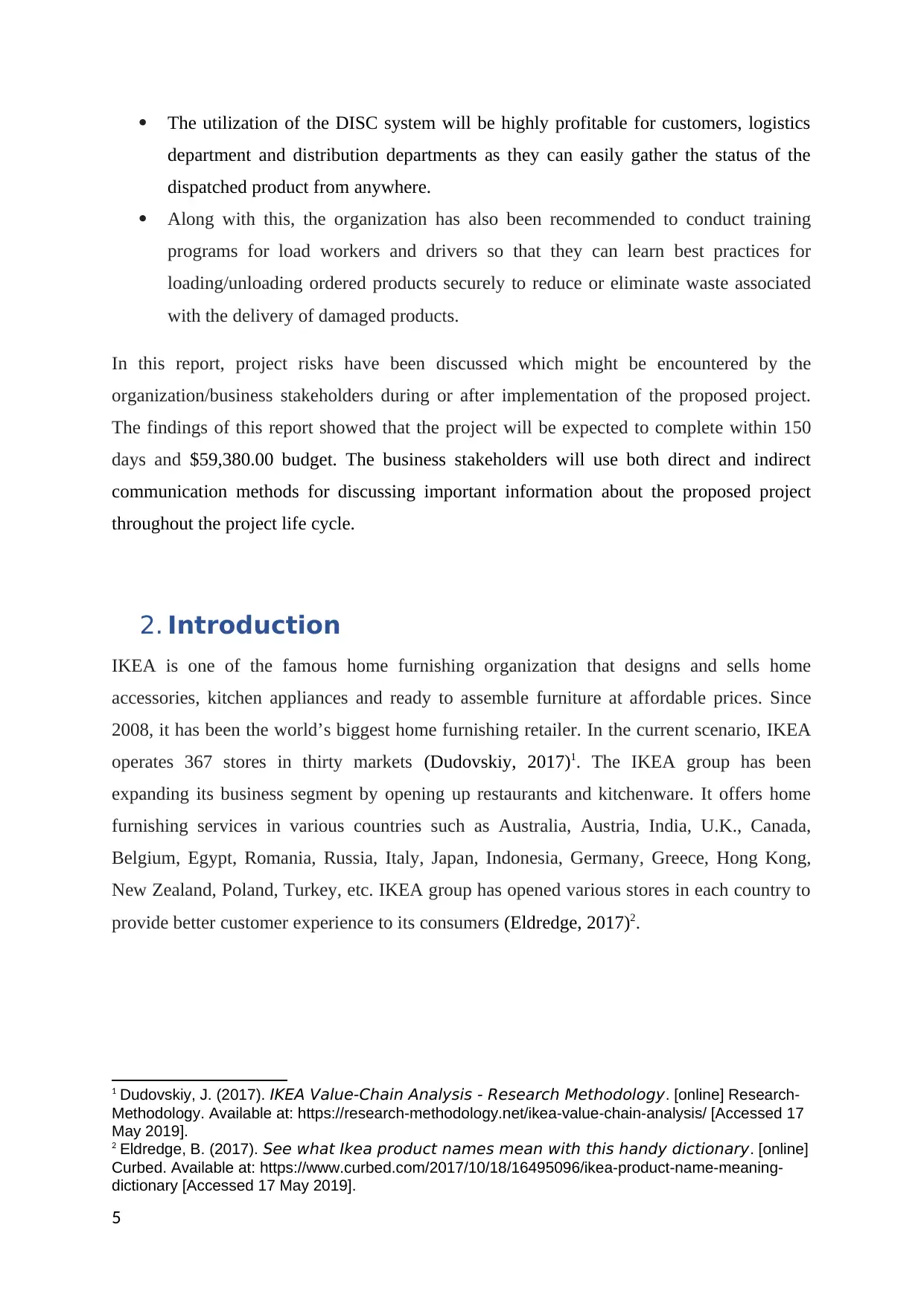
The utilization of the DISC system will be highly profitable for customers, logistics
department and distribution departments as they can easily gather the status of the
dispatched product from anywhere.
Along with this, the organization has also been recommended to conduct training
programs for load workers and drivers so that they can learn best practices for
loading/unloading ordered products securely to reduce or eliminate waste associated
with the delivery of damaged products.
In this report, project risks have been discussed which might be encountered by the
organization/business stakeholders during or after implementation of the proposed project.
The findings of this report showed that the project will be expected to complete within 150
days and $59,380.00 budget. The business stakeholders will use both direct and indirect
communication methods for discussing important information about the proposed project
throughout the project life cycle.
2. Introduction
IKEA is one of the famous home furnishing organization that designs and sells home
accessories, kitchen appliances and ready to assemble furniture at affordable prices. Since
2008, it has been the world’s biggest home furnishing retailer. In the current scenario, IKEA
operates 367 stores in thirty markets (Dudovskiy, 2017)1. The IKEA group has been
expanding its business segment by opening up restaurants and kitchenware. It offers home
furnishing services in various countries such as Australia, Austria, India, U.K., Canada,
Belgium, Egypt, Romania, Russia, Italy, Japan, Indonesia, Germany, Greece, Hong Kong,
New Zealand, Poland, Turkey, etc. IKEA group has opened various stores in each country to
provide better customer experience to its consumers (Eldredge, 2017)2.
1 Dudovskiy, J. (2017). IKEA Value-Chain Analysis - Research Methodology. [online] Research-
Methodology. Available at: https://research-methodology.net/ikea-value-chain-analysis/ [Accessed 17
May 2019].
2 Eldredge, B. (2017). See what Ikea product names mean with this handy dictionary. [online]
Curbed. Available at: https://www.curbed.com/2017/10/18/16495096/ikea-product-name-meaning-
dictionary [Accessed 17 May 2019].
5
department and distribution departments as they can easily gather the status of the
dispatched product from anywhere.
Along with this, the organization has also been recommended to conduct training
programs for load workers and drivers so that they can learn best practices for
loading/unloading ordered products securely to reduce or eliminate waste associated
with the delivery of damaged products.
In this report, project risks have been discussed which might be encountered by the
organization/business stakeholders during or after implementation of the proposed project.
The findings of this report showed that the project will be expected to complete within 150
days and $59,380.00 budget. The business stakeholders will use both direct and indirect
communication methods for discussing important information about the proposed project
throughout the project life cycle.
2. Introduction
IKEA is one of the famous home furnishing organization that designs and sells home
accessories, kitchen appliances and ready to assemble furniture at affordable prices. Since
2008, it has been the world’s biggest home furnishing retailer. In the current scenario, IKEA
operates 367 stores in thirty markets (Dudovskiy, 2017)1. The IKEA group has been
expanding its business segment by opening up restaurants and kitchenware. It offers home
furnishing services in various countries such as Australia, Austria, India, U.K., Canada,
Belgium, Egypt, Romania, Russia, Italy, Japan, Indonesia, Germany, Greece, Hong Kong,
New Zealand, Poland, Turkey, etc. IKEA group has opened various stores in each country to
provide better customer experience to its consumers (Eldredge, 2017)2.
1 Dudovskiy, J. (2017). IKEA Value-Chain Analysis - Research Methodology. [online] Research-
Methodology. Available at: https://research-methodology.net/ikea-value-chain-analysis/ [Accessed 17
May 2019].
2 Eldredge, B. (2017). See what Ikea product names mean with this handy dictionary. [online]
Curbed. Available at: https://www.curbed.com/2017/10/18/16495096/ikea-product-name-meaning-
dictionary [Accessed 17 May 2019].
5
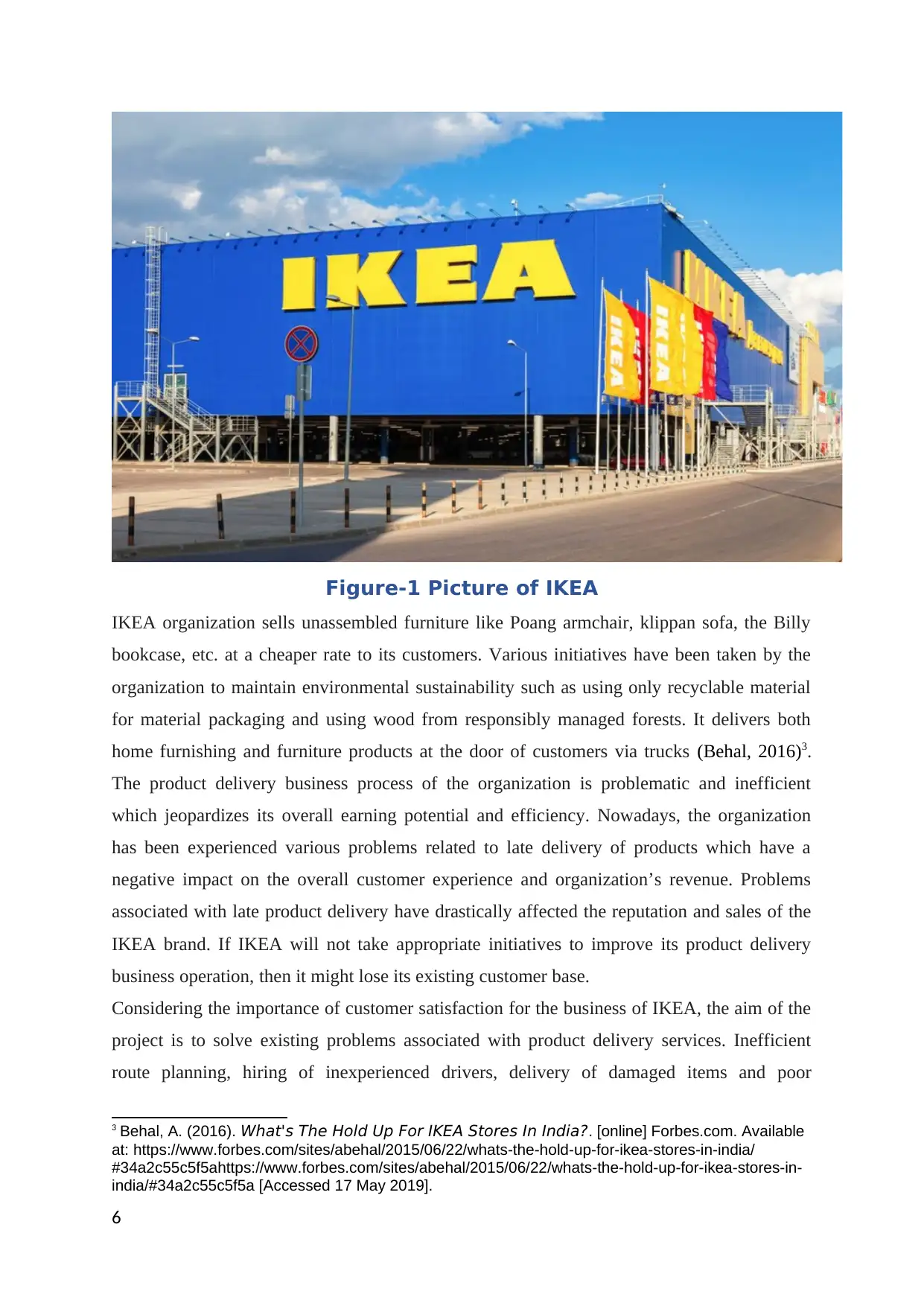
Figure-1 Picture of IKEA
IKEA organization sells unassembled furniture like Poang armchair, klippan sofa, the Billy
bookcase, etc. at a cheaper rate to its customers. Various initiatives have been taken by the
organization to maintain environmental sustainability such as using only recyclable material
for material packaging and using wood from responsibly managed forests. It delivers both
home furnishing and furniture products at the door of customers via trucks (Behal, 2016)3.
The product delivery business process of the organization is problematic and inefficient
which jeopardizes its overall earning potential and efficiency. Nowadays, the organization
has been experienced various problems related to late delivery of products which have a
negative impact on the overall customer experience and organization’s revenue. Problems
associated with late product delivery have drastically affected the reputation and sales of the
IKEA brand. If IKEA will not take appropriate initiatives to improve its product delivery
business operation, then it might lose its existing customer base.
Considering the importance of customer satisfaction for the business of IKEA, the aim of the
project is to solve existing problems associated with product delivery services. Inefficient
route planning, hiring of inexperienced drivers, delivery of damaged items and poor
3 Behal, A. (2016). What's The Hold Up For IKEA Stores In India?. [online] Forbes.com. Available
at: https://www.forbes.com/sites/abehal/2015/06/22/whats-the-hold-up-for-ikea-stores-in-india/
#34a2c55c5f5ahttps://www.forbes.com/sites/abehal/2015/06/22/whats-the-hold-up-for-ikea-stores-in-
india/#34a2c55c5f5a [Accessed 17 May 2019].
6
IKEA organization sells unassembled furniture like Poang armchair, klippan sofa, the Billy
bookcase, etc. at a cheaper rate to its customers. Various initiatives have been taken by the
organization to maintain environmental sustainability such as using only recyclable material
for material packaging and using wood from responsibly managed forests. It delivers both
home furnishing and furniture products at the door of customers via trucks (Behal, 2016)3.
The product delivery business process of the organization is problematic and inefficient
which jeopardizes its overall earning potential and efficiency. Nowadays, the organization
has been experienced various problems related to late delivery of products which have a
negative impact on the overall customer experience and organization’s revenue. Problems
associated with late product delivery have drastically affected the reputation and sales of the
IKEA brand. If IKEA will not take appropriate initiatives to improve its product delivery
business operation, then it might lose its existing customer base.
Considering the importance of customer satisfaction for the business of IKEA, the aim of the
project is to solve existing problems associated with product delivery services. Inefficient
route planning, hiring of inexperienced drivers, delivery of damaged items and poor
3 Behal, A. (2016). What's The Hold Up For IKEA Stores In India?. [online] Forbes.com. Available
at: https://www.forbes.com/sites/abehal/2015/06/22/whats-the-hold-up-for-ikea-stores-in-india/
#34a2c55c5f5ahttps://www.forbes.com/sites/abehal/2015/06/22/whats-the-hold-up-for-ikea-stores-in-
india/#34a2c55c5f5a [Accessed 17 May 2019].
6
⊘ This is a preview!⊘
Do you want full access?
Subscribe today to unlock all pages.

Trusted by 1+ million students worldwide
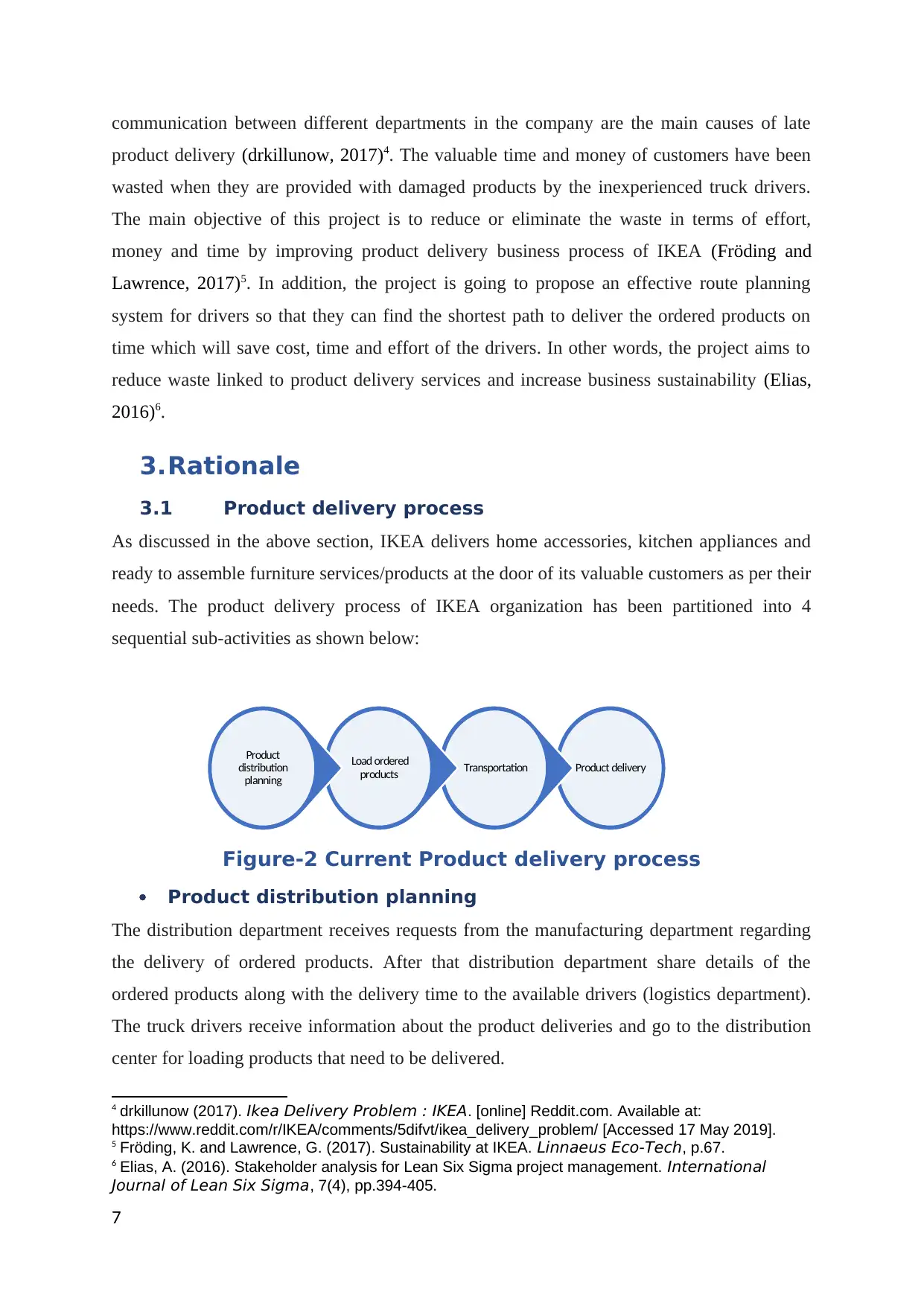
communication between different departments in the company are the main causes of late
product delivery (drkillunow, 2017)4. The valuable time and money of customers have been
wasted when they are provided with damaged products by the inexperienced truck drivers.
The main objective of this project is to reduce or eliminate the waste in terms of effort,
money and time by improving product delivery business process of IKEA (Fröding and
Lawrence, 2017)5. In addition, the project is going to propose an effective route planning
system for drivers so that they can find the shortest path to deliver the ordered products on
time which will save cost, time and effort of the drivers. In other words, the project aims to
reduce waste linked to product delivery services and increase business sustainability (Elias,
2016)6.
3.Rationale
3.1 Product delivery process
As discussed in the above section, IKEA delivers home accessories, kitchen appliances and
ready to assemble furniture services/products at the door of its valuable customers as per their
needs. The product delivery process of IKEA organization has been partitioned into 4
sequential sub-activities as shown below:
Figure-2 Current Product delivery process
Product distribution planning
The distribution department receives requests from the manufacturing department regarding
the delivery of ordered products. After that distribution department share details of the
ordered products along with the delivery time to the available drivers (logistics department).
The truck drivers receive information about the product deliveries and go to the distribution
center for loading products that need to be delivered.
4 drkillunow (2017). Ikea Delivery Problem : IKEA. [online] Reddit.com. Available at:
https://www.reddit.com/r/IKEA/comments/5difvt/ikea_delivery_problem/ [Accessed 17 May 2019].
5 Fröding, K. and Lawrence, G. (2017). Sustainability at IKEA. Linnaeus Eco-Tech, p.67.
6 Elias, A. (2016). Stakeholder analysis for Lean Six Sigma project management. International
Journal of Lean Six Sigma, 7(4), pp.394-405.
7
Product deliveryTransportation
Load ordered
products
Product
distribution
planning
product delivery (drkillunow, 2017)4. The valuable time and money of customers have been
wasted when they are provided with damaged products by the inexperienced truck drivers.
The main objective of this project is to reduce or eliminate the waste in terms of effort,
money and time by improving product delivery business process of IKEA (Fröding and
Lawrence, 2017)5. In addition, the project is going to propose an effective route planning
system for drivers so that they can find the shortest path to deliver the ordered products on
time which will save cost, time and effort of the drivers. In other words, the project aims to
reduce waste linked to product delivery services and increase business sustainability (Elias,
2016)6.
3.Rationale
3.1 Product delivery process
As discussed in the above section, IKEA delivers home accessories, kitchen appliances and
ready to assemble furniture services/products at the door of its valuable customers as per their
needs. The product delivery process of IKEA organization has been partitioned into 4
sequential sub-activities as shown below:
Figure-2 Current Product delivery process
Product distribution planning
The distribution department receives requests from the manufacturing department regarding
the delivery of ordered products. After that distribution department share details of the
ordered products along with the delivery time to the available drivers (logistics department).
The truck drivers receive information about the product deliveries and go to the distribution
center for loading products that need to be delivered.
4 drkillunow (2017). Ikea Delivery Problem : IKEA. [online] Reddit.com. Available at:
https://www.reddit.com/r/IKEA/comments/5difvt/ikea_delivery_problem/ [Accessed 17 May 2019].
5 Fröding, K. and Lawrence, G. (2017). Sustainability at IKEA. Linnaeus Eco-Tech, p.67.
6 Elias, A. (2016). Stakeholder analysis for Lean Six Sigma project management. International
Journal of Lean Six Sigma, 7(4), pp.394-405.
7
Product deliveryTransportation
Load ordered
products
Product
distribution
planning
Paraphrase This Document
Need a fresh take? Get an instant paraphrase of this document with our AI Paraphraser
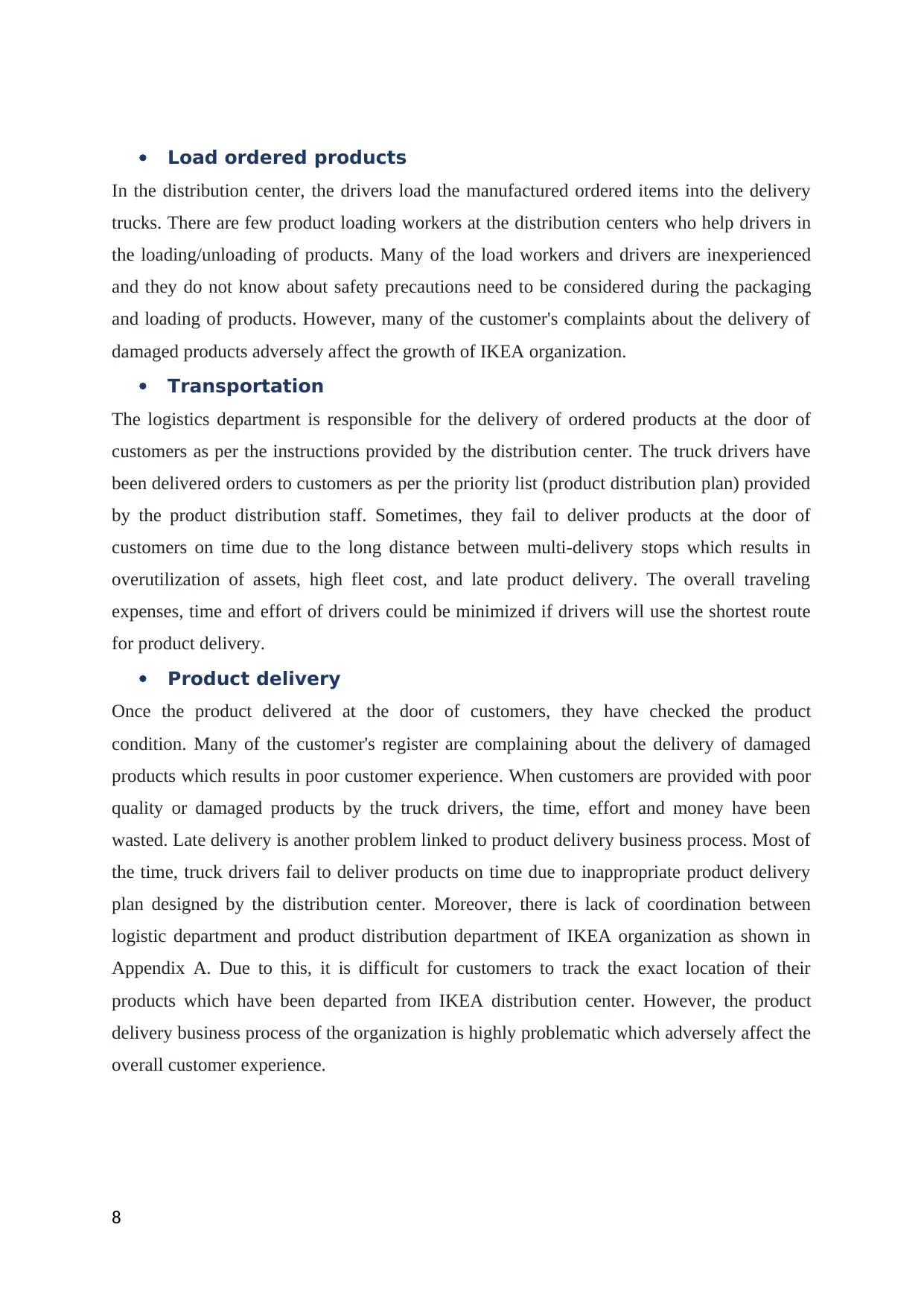
Load ordered products
In the distribution center, the drivers load the manufactured ordered items into the delivery
trucks. There are few product loading workers at the distribution centers who help drivers in
the loading/unloading of products. Many of the load workers and drivers are inexperienced
and they do not know about safety precautions need to be considered during the packaging
and loading of products. However, many of the customer's complaints about the delivery of
damaged products adversely affect the growth of IKEA organization.
Transportation
The logistics department is responsible for the delivery of ordered products at the door of
customers as per the instructions provided by the distribution center. The truck drivers have
been delivered orders to customers as per the priority list (product distribution plan) provided
by the product distribution staff. Sometimes, they fail to deliver products at the door of
customers on time due to the long distance between multi-delivery stops which results in
overutilization of assets, high fleet cost, and late product delivery. The overall traveling
expenses, time and effort of drivers could be minimized if drivers will use the shortest route
for product delivery.
Product delivery
Once the product delivered at the door of customers, they have checked the product
condition. Many of the customer's register are complaining about the delivery of damaged
products which results in poor customer experience. When customers are provided with poor
quality or damaged products by the truck drivers, the time, effort and money have been
wasted. Late delivery is another problem linked to product delivery business process. Most of
the time, truck drivers fail to deliver products on time due to inappropriate product delivery
plan designed by the distribution center. Moreover, there is lack of coordination between
logistic department and product distribution department of IKEA organization as shown in
Appendix A. Due to this, it is difficult for customers to track the exact location of their
products which have been departed from IKEA distribution center. However, the product
delivery business process of the organization is highly problematic which adversely affect the
overall customer experience.
8
In the distribution center, the drivers load the manufactured ordered items into the delivery
trucks. There are few product loading workers at the distribution centers who help drivers in
the loading/unloading of products. Many of the load workers and drivers are inexperienced
and they do not know about safety precautions need to be considered during the packaging
and loading of products. However, many of the customer's complaints about the delivery of
damaged products adversely affect the growth of IKEA organization.
Transportation
The logistics department is responsible for the delivery of ordered products at the door of
customers as per the instructions provided by the distribution center. The truck drivers have
been delivered orders to customers as per the priority list (product distribution plan) provided
by the product distribution staff. Sometimes, they fail to deliver products at the door of
customers on time due to the long distance between multi-delivery stops which results in
overutilization of assets, high fleet cost, and late product delivery. The overall traveling
expenses, time and effort of drivers could be minimized if drivers will use the shortest route
for product delivery.
Product delivery
Once the product delivered at the door of customers, they have checked the product
condition. Many of the customer's register are complaining about the delivery of damaged
products which results in poor customer experience. When customers are provided with poor
quality or damaged products by the truck drivers, the time, effort and money have been
wasted. Late delivery is another problem linked to product delivery business process. Most of
the time, truck drivers fail to deliver products on time due to inappropriate product delivery
plan designed by the distribution center. Moreover, there is lack of coordination between
logistic department and product distribution department of IKEA organization as shown in
Appendix A. Due to this, it is difficult for customers to track the exact location of their
products which have been departed from IKEA distribution center. However, the product
delivery business process of the organization is highly problematic which adversely affect the
overall customer experience.
8
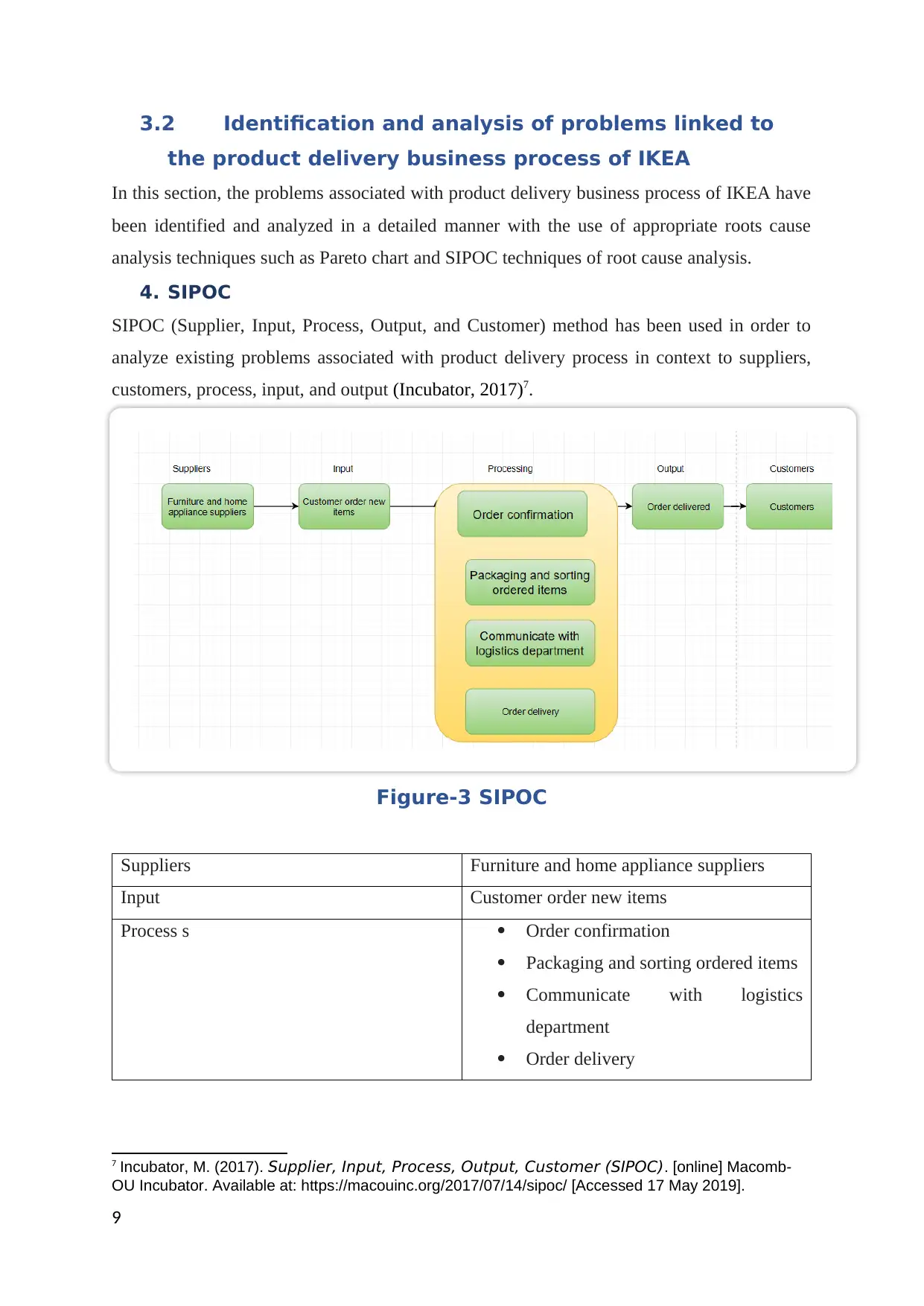
3.2 Identification and analysis of problems linked to
the product delivery business process of IKEA
In this section, the problems associated with product delivery business process of IKEA have
been identified and analyzed in a detailed manner with the use of appropriate roots cause
analysis techniques such as Pareto chart and SIPOC techniques of root cause analysis.
4. SIPOC
SIPOC (Supplier, Input, Process, Output, and Customer) method has been used in order to
analyze existing problems associated with product delivery process in context to suppliers,
customers, process, input, and output (Incubator, 2017)7.
Figure-3 SIPOC
Suppliers Furniture and home appliance suppliers
Input Customer order new items
Process s Order confirmation
Packaging and sorting ordered items
Communicate with logistics
department
Order delivery
7 Incubator, M. (2017). Supplier, Input, Process, Output, Customer (SIPOC). [online] Macomb-
OU Incubator. Available at: https://macouinc.org/2017/07/14/sipoc/ [Accessed 17 May 2019].
9
the product delivery business process of IKEA
In this section, the problems associated with product delivery business process of IKEA have
been identified and analyzed in a detailed manner with the use of appropriate roots cause
analysis techniques such as Pareto chart and SIPOC techniques of root cause analysis.
4. SIPOC
SIPOC (Supplier, Input, Process, Output, and Customer) method has been used in order to
analyze existing problems associated with product delivery process in context to suppliers,
customers, process, input, and output (Incubator, 2017)7.
Figure-3 SIPOC
Suppliers Furniture and home appliance suppliers
Input Customer order new items
Process s Order confirmation
Packaging and sorting ordered items
Communicate with logistics
department
Order delivery
7 Incubator, M. (2017). Supplier, Input, Process, Output, Customer (SIPOC). [online] Macomb-
OU Incubator. Available at: https://macouinc.org/2017/07/14/sipoc/ [Accessed 17 May 2019].
9
⊘ This is a preview!⊘
Do you want full access?
Subscribe today to unlock all pages.

Trusted by 1+ million students worldwide
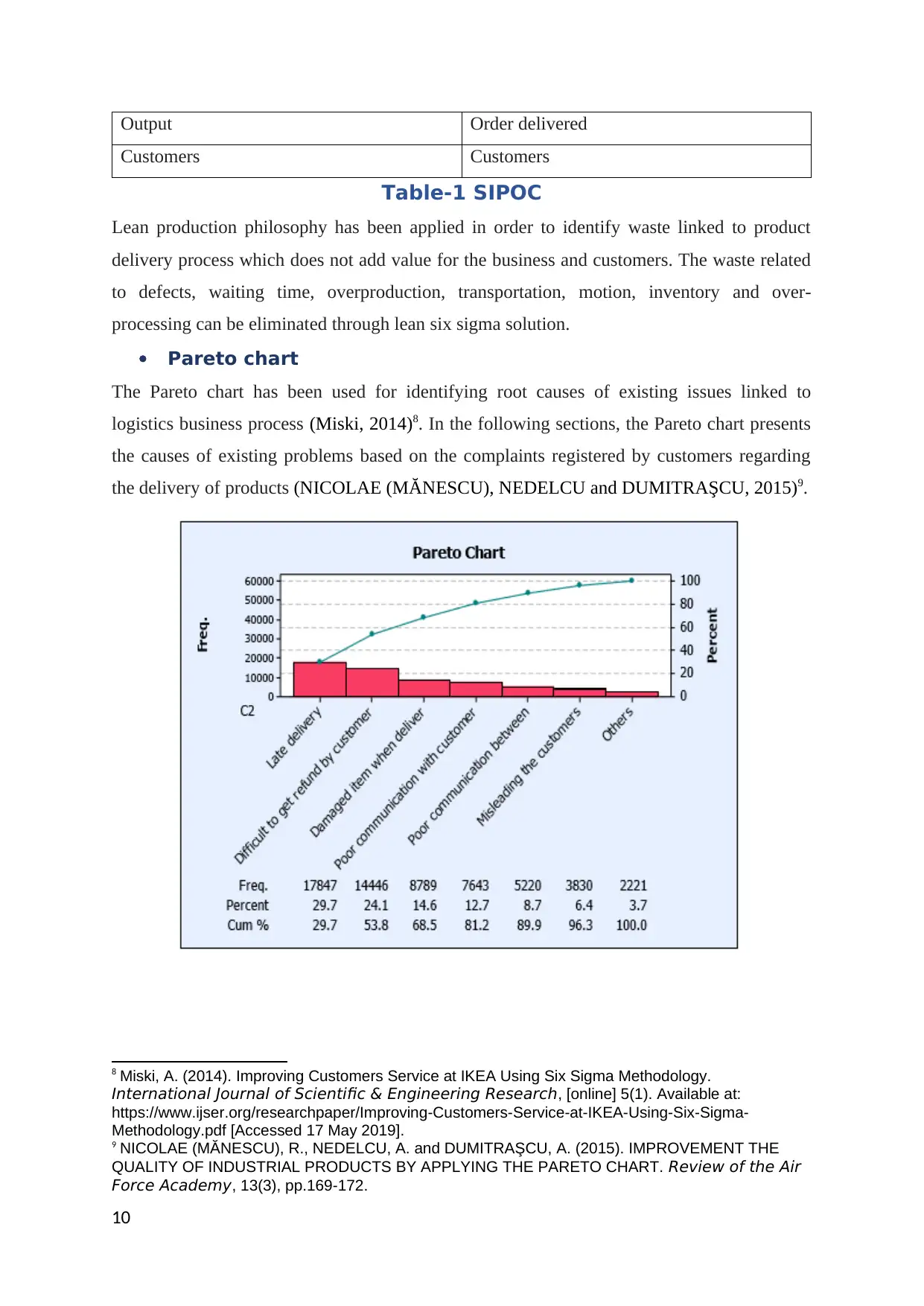
Output Order delivered
Customers Customers
Table-1 SIPOC
Lean production philosophy has been applied in order to identify waste linked to product
delivery process which does not add value for the business and customers. The waste related
to defects, waiting time, overproduction, transportation, motion, inventory and over-
processing can be eliminated through lean six sigma solution.
Pareto chart
The Pareto chart has been used for identifying root causes of existing issues linked to
logistics business process (Miski, 2014)8. In the following sections, the Pareto chart presents
the causes of existing problems based on the complaints registered by customers regarding
the delivery of products (NICOLAE (MĂNESCU), NEDELCU and DUMITRAŞCU, 2015)9.
8 Miski, A. (2014). Improving Customers Service at IKEA Using Six Sigma Methodology.
International Journal of Scientific & Engineering Research, [online] 5(1). Available at:
https://www.ijser.org/researchpaper/Improving-Customers-Service-at-IKEA-Using-Six-Sigma-
Methodology.pdf [Accessed 17 May 2019].
9 NICOLAE (MĂNESCU), R., NEDELCU, A. and DUMITRAŞCU, A. (2015). IMPROVEMENT THE
QUALITY OF INDUSTRIAL PRODUCTS BY APPLYING THE PARETO CHART. Review of the Air
Force Academy, 13(3), pp.169-172.
10
Customers Customers
Table-1 SIPOC
Lean production philosophy has been applied in order to identify waste linked to product
delivery process which does not add value for the business and customers. The waste related
to defects, waiting time, overproduction, transportation, motion, inventory and over-
processing can be eliminated through lean six sigma solution.
Pareto chart
The Pareto chart has been used for identifying root causes of existing issues linked to
logistics business process (Miski, 2014)8. In the following sections, the Pareto chart presents
the causes of existing problems based on the complaints registered by customers regarding
the delivery of products (NICOLAE (MĂNESCU), NEDELCU and DUMITRAŞCU, 2015)9.
8 Miski, A. (2014). Improving Customers Service at IKEA Using Six Sigma Methodology.
International Journal of Scientific & Engineering Research, [online] 5(1). Available at:
https://www.ijser.org/researchpaper/Improving-Customers-Service-at-IKEA-Using-Six-Sigma-
Methodology.pdf [Accessed 17 May 2019].
9 NICOLAE (MĂNESCU), R., NEDELCU, A. and DUMITRAŞCU, A. (2015). IMPROVEMENT THE
QUALITY OF INDUSTRIAL PRODUCTS BY APPLYING THE PARETO CHART. Review of the Air
Force Academy, 13(3), pp.169-172.
10
Paraphrase This Document
Need a fresh take? Get an instant paraphrase of this document with our AI Paraphraser
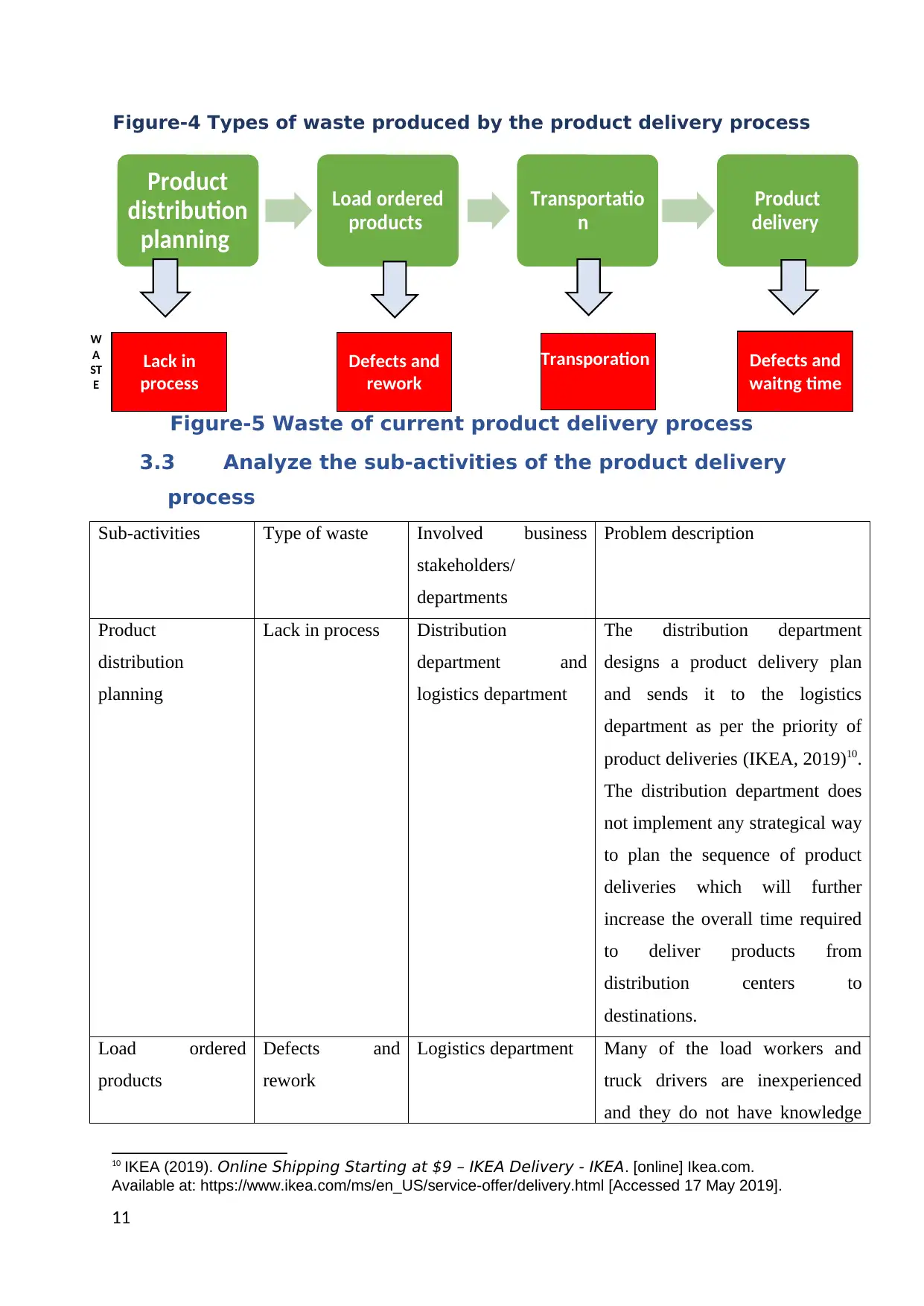
Figure-4 Types of waste produced by the product delivery process
Figure-5 Waste of current product delivery process
3.3 Analyze the sub-activities of the product delivery
process
Sub-activities Type of waste Involved business
stakeholders/
departments
Problem description
Product
distribution
planning
Lack in process Distribution
department and
logistics department
The distribution department
designs a product delivery plan
and sends it to the logistics
department as per the priority of
product deliveries (IKEA, 2019)10.
The distribution department does
not implement any strategical way
to plan the sequence of product
deliveries which will further
increase the overall time required
to deliver products from
distribution centers to
destinations.
Load ordered
products
Defects and
rework
Logistics department Many of the load workers and
truck drivers are inexperienced
and they do not have knowledge
10 IKEA (2019). Online Shipping Starting at $9 – IKEA Delivery - IKEA. [online] Ikea.com.
Available at: https://www.ikea.com/ms/en_US/service-offer/delivery.html [Accessed 17 May 2019].
11
Product
distribution
planning
Load ordered
products
Transportatio
n
Product
delivery
Defects and
rework
Transporation Defects and
waitng time
W
A
ST
E
Lack in
process
Figure-5 Waste of current product delivery process
3.3 Analyze the sub-activities of the product delivery
process
Sub-activities Type of waste Involved business
stakeholders/
departments
Problem description
Product
distribution
planning
Lack in process Distribution
department and
logistics department
The distribution department
designs a product delivery plan
and sends it to the logistics
department as per the priority of
product deliveries (IKEA, 2019)10.
The distribution department does
not implement any strategical way
to plan the sequence of product
deliveries which will further
increase the overall time required
to deliver products from
distribution centers to
destinations.
Load ordered
products
Defects and
rework
Logistics department Many of the load workers and
truck drivers are inexperienced
and they do not have knowledge
10 IKEA (2019). Online Shipping Starting at $9 – IKEA Delivery - IKEA. [online] Ikea.com.
Available at: https://www.ikea.com/ms/en_US/service-offer/delivery.html [Accessed 17 May 2019].
11
Product
distribution
planning
Load ordered
products
Transportatio
n
Product
delivery
Defects and
rework
Transporation Defects and
waitng time
W
A
ST
E
Lack in
process
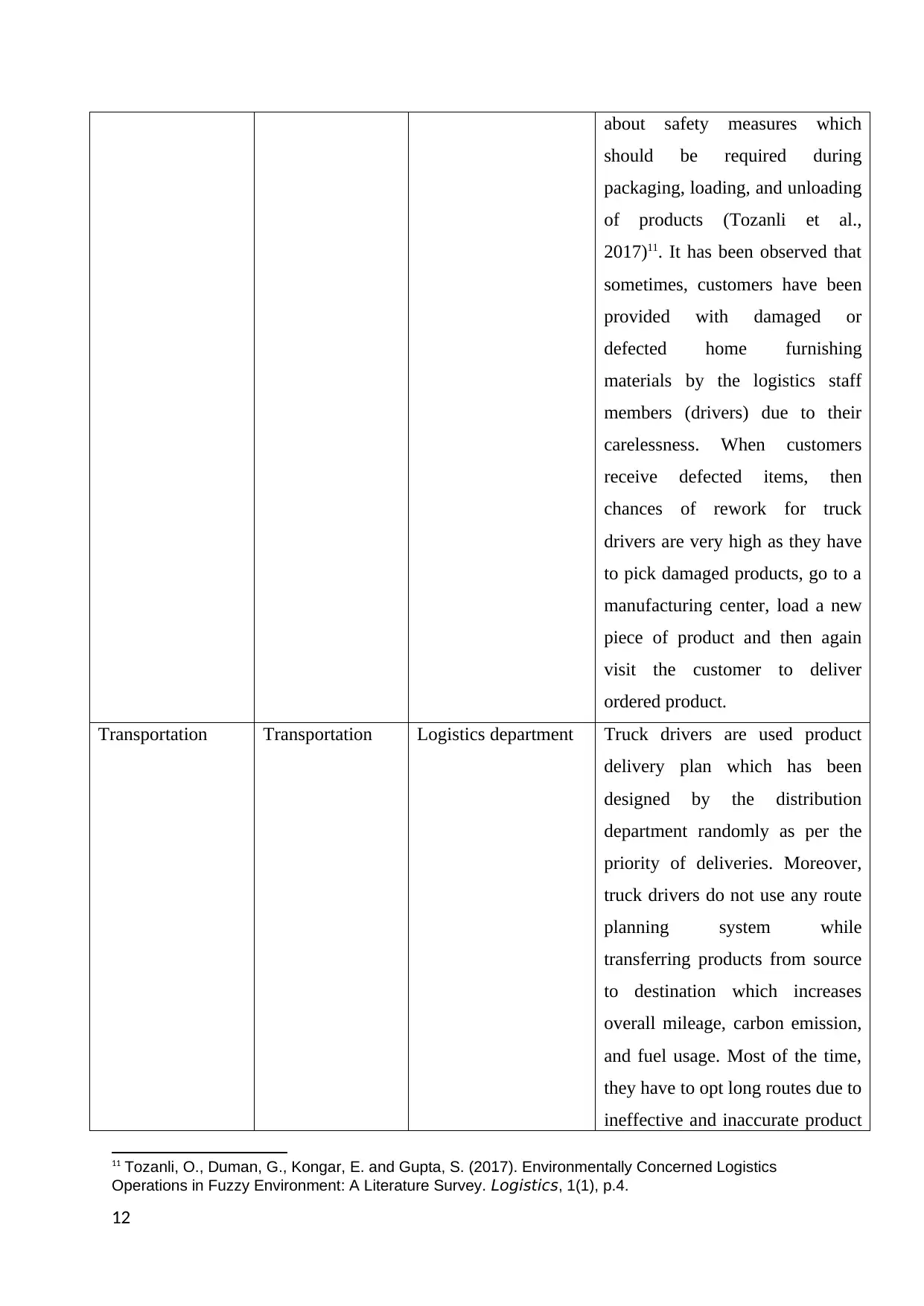
about safety measures which
should be required during
packaging, loading, and unloading
of products (Tozanli et al.,
2017)11. It has been observed that
sometimes, customers have been
provided with damaged or
defected home furnishing
materials by the logistics staff
members (drivers) due to their
carelessness. When customers
receive defected items, then
chances of rework for truck
drivers are very high as they have
to pick damaged products, go to a
manufacturing center, load a new
piece of product and then again
visit the customer to deliver
ordered product.
Transportation Transportation Logistics department Truck drivers are used product
delivery plan which has been
designed by the distribution
department randomly as per the
priority of deliveries. Moreover,
truck drivers do not use any route
planning system while
transferring products from source
to destination which increases
overall mileage, carbon emission,
and fuel usage. Most of the time,
they have to opt long routes due to
ineffective and inaccurate product
11 Tozanli, O., Duman, G., Kongar, E. and Gupta, S. (2017). Environmentally Concerned Logistics
Operations in Fuzzy Environment: A Literature Survey. Logistics, 1(1), p.4.
12
should be required during
packaging, loading, and unloading
of products (Tozanli et al.,
2017)11. It has been observed that
sometimes, customers have been
provided with damaged or
defected home furnishing
materials by the logistics staff
members (drivers) due to their
carelessness. When customers
receive defected items, then
chances of rework for truck
drivers are very high as they have
to pick damaged products, go to a
manufacturing center, load a new
piece of product and then again
visit the customer to deliver
ordered product.
Transportation Transportation Logistics department Truck drivers are used product
delivery plan which has been
designed by the distribution
department randomly as per the
priority of deliveries. Moreover,
truck drivers do not use any route
planning system while
transferring products from source
to destination which increases
overall mileage, carbon emission,
and fuel usage. Most of the time,
they have to opt long routes due to
ineffective and inaccurate product
11 Tozanli, O., Duman, G., Kongar, E. and Gupta, S. (2017). Environmentally Concerned Logistics
Operations in Fuzzy Environment: A Literature Survey. Logistics, 1(1), p.4.
12
⊘ This is a preview!⊘
Do you want full access?
Subscribe today to unlock all pages.

Trusted by 1+ million students worldwide
1 out of 30
Your All-in-One AI-Powered Toolkit for Academic Success.
+13062052269
info@desklib.com
Available 24*7 on WhatsApp / Email
![[object Object]](/_next/static/media/star-bottom.7253800d.svg)
Unlock your academic potential
Copyright © 2020–2025 A2Z Services. All Rights Reserved. Developed and managed by ZUCOL.
